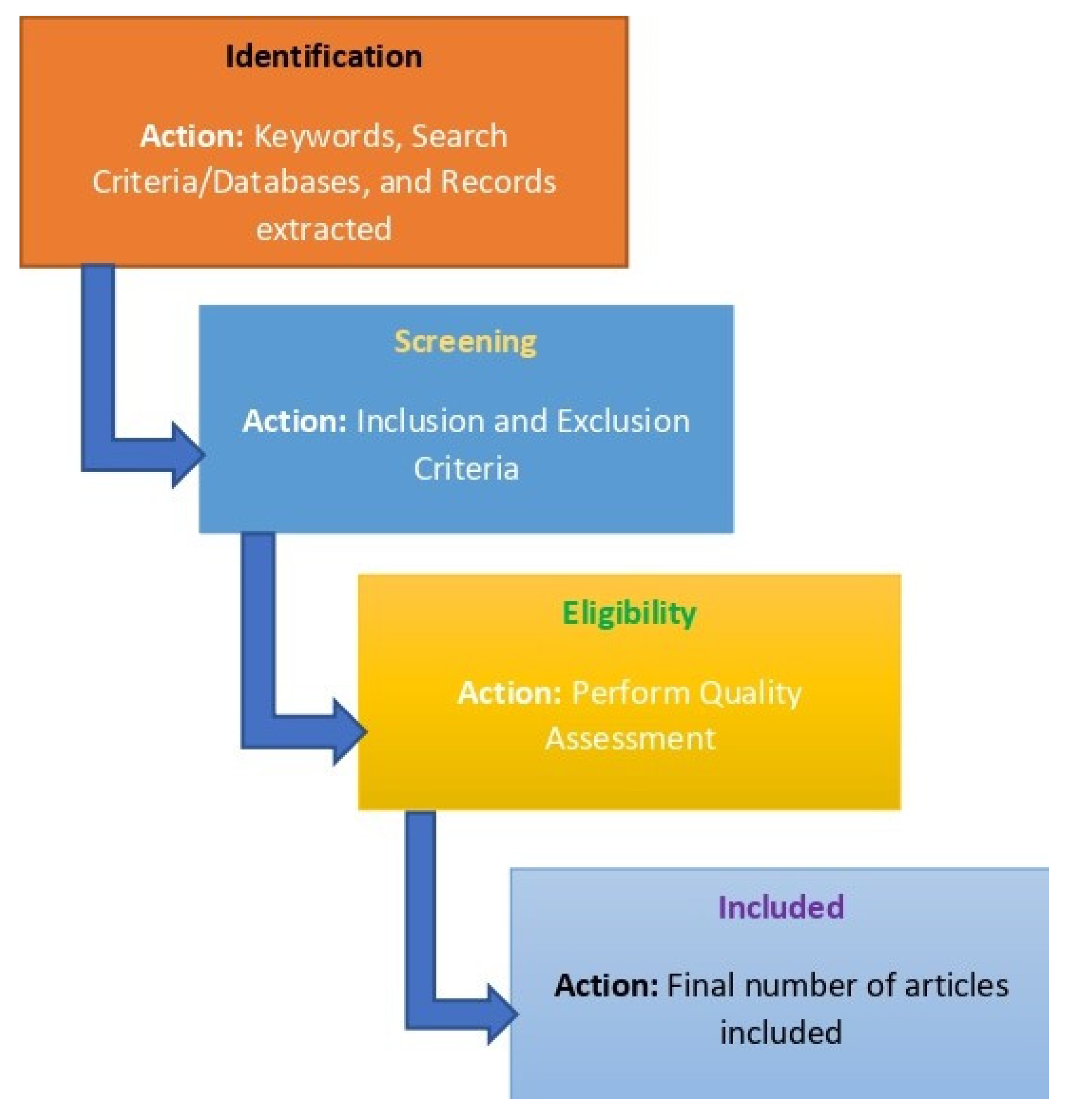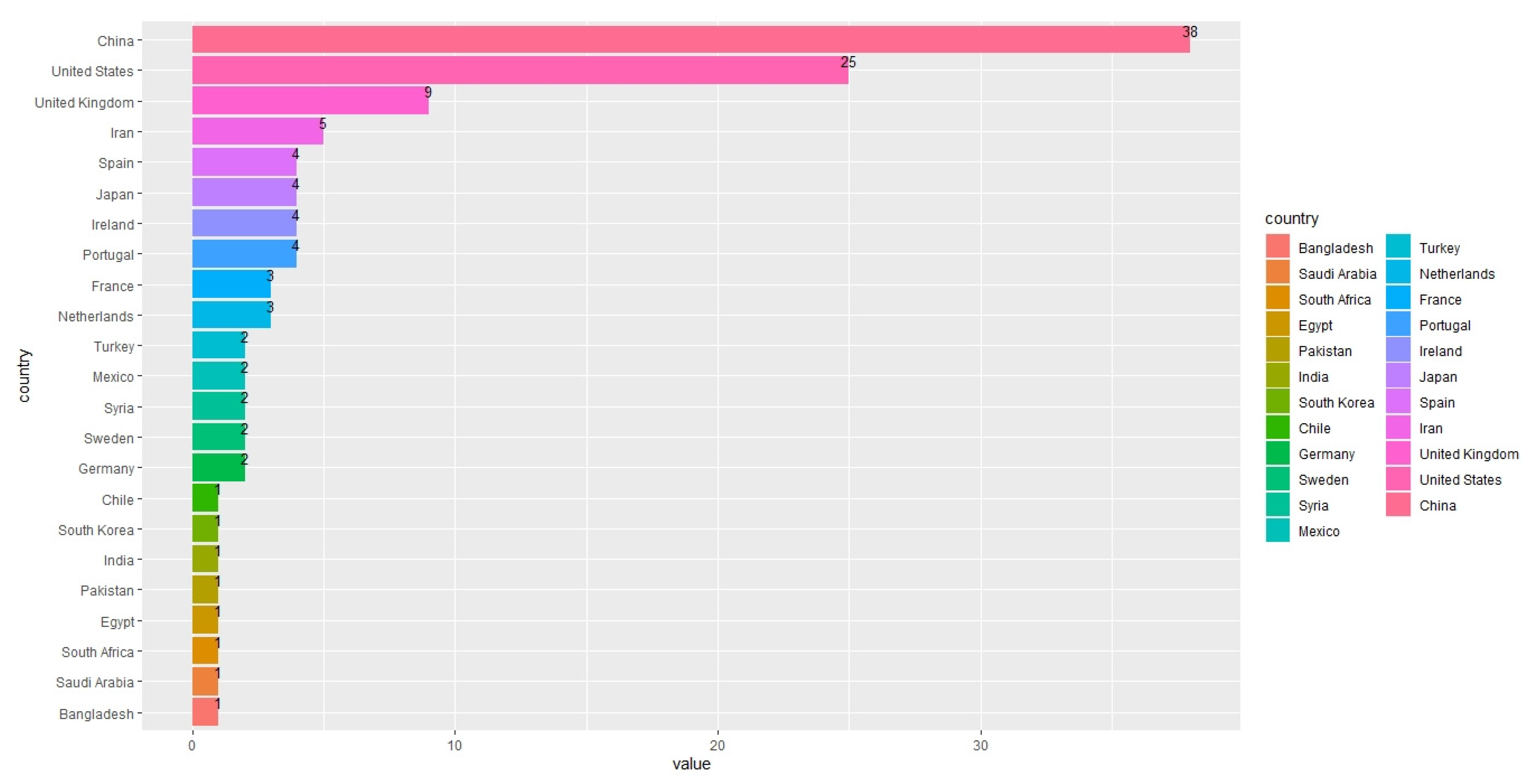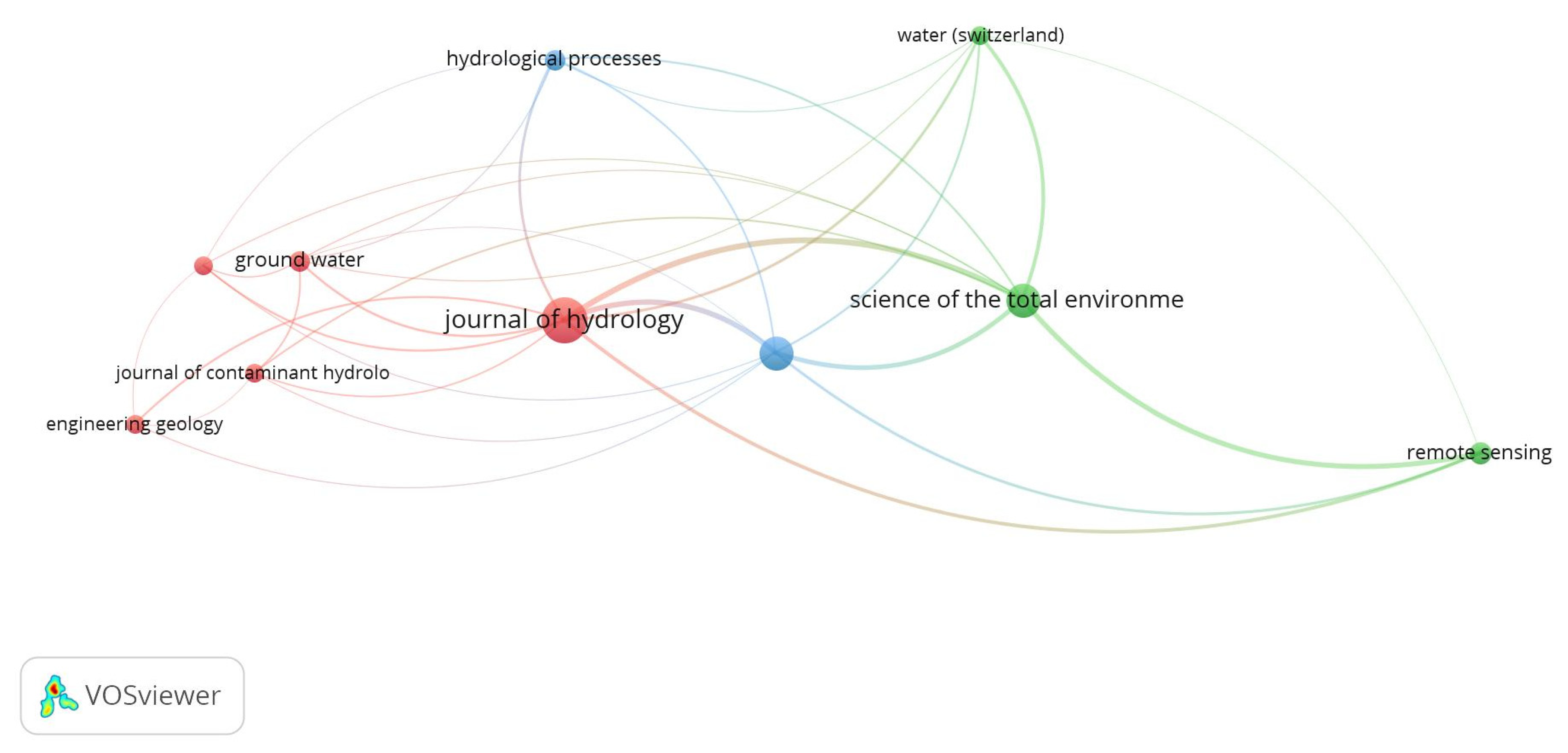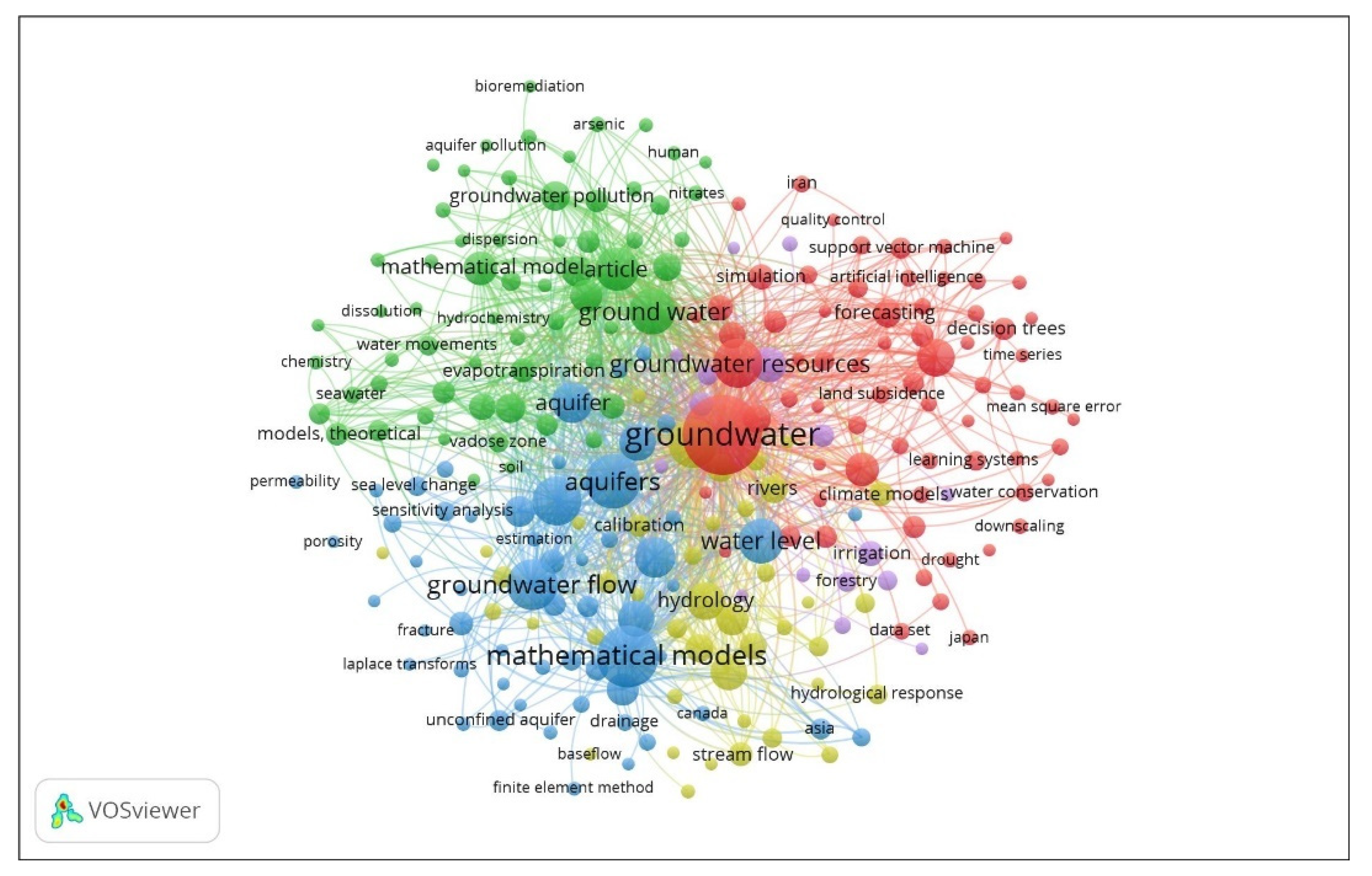Appendix A. List of Primary Studies (PS) in this Literature
Appendix A provides the list of primary studies (PS) used in this literature.
[PS1] Q. Liu et al., “Simulation of regional groundwater levels in arid regions using interpretable machine learning models,” Sci. Total Environ., vol. 831, no. 2022, p. 154902, 2022.
[PS2] H. Part, “Machine Learning Algorithms for soil”. pp. 1–17, 2017.
[PS3] L. Shi, H. Gong, B. Chen, and C. Zhou, “Land subsidence prediction induced by multiple factors using machine learning method,” Remote Sens., vol. 12, no. 24, pp. 1–17, 2020.
[PS4] A. T. M. S. Rahman, T. Hosono, J. M. Quilty, J. Das, and A. Basak, “Multiscale groundwater level forecasting: Coupling new machine learning approaches with wavelet transforms,” Adv. Water Resour., vol. 141, no. May, 2020.
[PS5] Z. Gaffoor, A. Gritzman, K. Pietersen, N. Jovanovic, A. Bagula, and T. Kanyerere, “An autoregressive machine learning approach to forecast high-resolution groundwater-level anomalies in the Ramotswa/North West/Gauteng dolomite aquifers of Southern Africa,” Hydrogeol. J., vol. 30, no. 2, pp. 575–600, 2022.
[PS6] P. J. Jyolsna, B. V. N. P. Kambhammettu, and S. Gorugantula, “Application of random forest and multi-linear regression methods in downscaling GRACE derived groundwater storage changes,” Hydrol. Sci. J., vol. 66, no. 5, pp. 874–887, 2021.
[PS7] Z. Kayhomayoon, F. Babaeian, S. G. Milan, and N. A. Azar, “A Combination of Metaheuristic Optimization Algorithms and Machine Learning Methods Improves the Prediction of Groundwater Level,” pp. 1–25, 2022.
[PS8] B. D. B. J. M. S. mohamed M. Morsey, “Forecasting Groundwater Table in a Flood Prone Coastal City with Long Short-term Memory and Recurrent Neural Networks,” 2019.
[PS9] A. P. Dadhich, R. Goyal, and P. N. Dadhich, “Assessment and Prediction of Groundwater using Geospatial and ANN Modeling,” Water Resour. Manag., vol. 35, no. 9, pp. 2879–2893, 2021.
[PS10] E. Jeihouni, M. Mohammadi, S. Eslamian, and M. J. Zareian, “Potential impacts of climate change on groundwater level through hybrid soft-computing methods: a case study—Shabestar Plain, Iran,” Environ. Monit. Assess., vol. 191, no. 10, 2019.
[PS11] M. E. Miro, D. Groves, B. Tincher, J. Syme, S. Tanverakul, and D. Catt, “Adaptive water management in the face of uncertainty: Integrating machine learning, groundwater modeling and robust decision making,” Clim. Risk Manag., vol. 34, no. May, p. 100383, 2021.
[PS12] S. Ali et al., “Improving the resolution of grace data for spatio-temporal groundwater storage assessment,” Remote Sens., vol. 13, no. 17, 2021.
[PS13] H. Li et al., “Spatiotemporal modeling of land subsidence using a geographically weighted deep learning method based on PS-InSAR,” Sci. Total Environ., vol. 799, p. 149244, 2021.
[PS14] W. M. S. D. K. A. M. Milewski, “Downscaling GRACE TWSA data into high-resolution groundwater level anomaly using machine learning-based models in a glacial aquifer system,” MDPI, 2019.
[PS15] H. Han, B. Shi, and L. Zhang, “Prediction of landslide sharp increase displacement by SVM with considering hysteresis of groundwater change,” Eng. Geol., vol. 280, no. August 2020, p. 105876, 2021.
[PS16] S. Sithara, P. S K, and S. G. Thampi, “Impact of projected climate change on seawater intrusion on a regional coastal aquifer,” J. Earth Syst. Sci., vol. 129, no. 1, 2020.
[PS17] Z. Jiang et al., “Can ensemble machine learning be used to predict the groundwater level dynamics of farmland under future climate: a 10-year study on Huaibei Plain,” Environ. Sci. Pollut. Res., no. 0123456789, 2022.
[PS18] A. Wunsch, T. Liesch, and S. Broda, “Deep learning shows declining groundwater levels in Germany until 2100 due to climate change,” Nat. Commun., vol. 13, no. 1, pp. 1–13, 2022.
[PS19] D. Liu, A. K. Mishra, Z. Yu, H. Lü, and Y. Li, “Support vector machine and data assimilation framework for Groundwater Level Forecasting using GRACE satellite data,” J. Hydrol., vol. 603, no. PA, p. 126929, 2021.
[PS20] S. Sahoo, T. A. Russo, J. Elliott, and I. Foster, “Machine learning algorithms for modeling groundwater level changes in agricultural regions of the U.S.,” Water Resources Research, vol. 53, no. 5. pp. 3878–3895, 2017.
[PS21] X. Yang, H. Zhang, and H. Zhou, “A Hybrid Methodology for Salinity Time Series Forecasting Based on Wavelet Transform and NARX Neural Networks,” Arab. J. Sci. Eng., vol. 39, no. 10, pp. 6895–6905, 2014.
[PS22] S. Sachdeva and B. Kumar, “A novel ensemble model of automatic multilayer perceptron, random forest, and ZeroR for groundwater potential mapping,” Environ. Monit. Assess., vol. 193, no. 11, 2021.
[PS23] K. Sun, L. Hu, J. Guo, Z. Yang, Y. Zhai, and S. Zhang, “Enhancing the understanding of hydrological responses induced by ecological water replenishment using improved machine learning models: A case study in Yongding River,” Sci. Total Environ., vol. 768, p. 145489, 2021.
[PS24] A. Manandhar, H. Greeff, P. Thomson, R. Hope, and D. A. Clifton, “Shallow aquifer monitoring using handpump vibration data,” J. Hydrol. X, vol. 8, no. May, 2020.
[PS25] W. Yin, Z. Fan, N. Tangdamrongsub, L. Hu, and M. Zhang, “Comparison of physical and data-driven models to forecast groundwater level changes with the inclusion of GRACE—A case study over the state of Victoria, Australia,” J. Hydrol., vol. 602, no. July, 2021.
[PS26] J. Chang, G. Wang, and T. Mao, “Simulation and prediction of suprapermafrost groundwater level variation in response to climate change using a neural network model,” J. Hydrol., vol. 529, pp. 1211–1220, 2015.
[PS27] E. A. O. O. S. S. T. Y. Reygadas, “Climate Change, Land Use/Land Cover Change, and Population Growth as Drivers of Groundwater Depletion in Central Valleys, Oaxaca, Mexico,” 2019.
[PS28] A. K. Sales, E. Gul, M. J. S. Safari, H. Ghodrat Gharehbagh, and B. Vaheddoost, “Urmia lake water depth modeling using extreme learning machine-improved grey wolf optimizer hybrid algorithm,” Theor. Appl. Climatol., vol. 146, no. 1–2, pp. 833–849, 2021.
[PS29] M. S. A. K. A. D. A. Kar, “On predictability of Groundwater Level in Shallow Wells Using Satellite Observations,” pp. 507–514, 2018.
[PS30] N. Iqbal et al., “Groundwater Level Prediction Model Using Correlation and Difference Mechanisms Based on Boreholes Data for Sustainable Hydraulic Resource Management,” IEEE Access, vol. 9, no. July, pp. 96092–96113, 2021.
[PS31] A. M. M. M. B. T. W. M. S. T. C. Rasmussen, “Spatial Downscaling of GRACE TWSA Data to Identify Spatiotemporal Groundwater Level Trends in the Upper Floridan Aquifer, Georgia, USA,” 2019.
[PS32] S. S. Malekzadeh M., Kardar S., “Simulation of groundwater level using MODFLOW, extreme learning machine and Wavelet-Extreme Learning Machine models,” Groundw. Sustain. Dev., 2019.
[PS33] B. Yadav, P. K. Gupta, N. Patidar, and S. K. Himanshu, “Ensemble modelling framework for groundwater level prediction in urban areas of India,” Sci. Total Environ., vol. 712, p. 135539, 2020.
[PS34] A. Amaranto, F. Munoz-Arriola, G. Corzo, D. P. Solomatine, and G. Meyer, “Semi-seasonal groundwater forecast using multiple data-driven models in an irrigated cropland,” J. Hydroinformatics, vol. 20, no. 6, pp. 1227–1246, 2018.
[PS35] F. Li, H. Gong, B. Chen, C. Zhou, and L. Guo, “Analysis of the contribution rate of the influencing factors to land subsidence in the eastern beijing plain, China based on extremely randomized trees (ERT) method,” Remote Sens., vol. 12, no. 18, pp. 1–21, 2020.
[PS36] E. C. J. M. J. X. jia; S. Kraatz, “Identifying Subsurface Drainage using Satellite Big Data and Machine Learning via Google Earth Engine,” 2019.
[PS37] R. Khatibi and A. A. Nadiri, “Inclusive Multiple Models (IMM) for predicting groundwater levels and treating heterogeneity,” Geosci. Front., vol. 12, no. 2, pp. 713–724, 2021.
[PS38] S. S. Band et al., “Comparative analysis of artificial intelligence models for accurate estimation of groundwater nitrate concentration,” Sensors (Switzerland), vol. 20, no. 20, pp. 1–23, 2020.
[PS39] Omid Rahmati; Ali Golkarian; Trent Biggs, “Land subsidence hazard modeling: Machine learning to identify predictors and the role of human activities,” J. Environ. Manage., 2019.
[PS40] Q. Cheng, F. Zhong, and P. Wang, “Baseflow dynamics and multivariate analysis using bivariate and multiple wavelet coherence in an alpine endorheic river basin (Northwest China),” Sci. Total Environ., vol. 772, p. 145013, 2021.
[PS41] R. Q. Gonzalez and J. J. Arsanjani, “Prediction of groundwater level variations in a changing climate: A danish case study,” ISPRS Int. J. Geo-Information, vol. 10, no. 11, 2021.
[PS42] A. Akter and S. Ahmed, “Modeling of groundwater level changes in an urban area,” Sustain. Water Resour. Manag., vol. 7, no. 1, 2021.
[PS43] F. B. Banadkooki et al., “Enhancement of Groundwater-Level Prediction Using an Integrated Machine Learning Model Optimized by Whale Algorithm,” Nat. Resour. Res., 2020.
[PS44] S. Lee, K. K. Lee, and H. Yoon, “Using artificial neural network models for groundwater level forecasting and assessment of the relative impacts of influencing factors,” Hydrogeol. J., vol. 27, no. 2, pp. 567–579, 2019.
[PS45] A. Khedri, N. Kalantari, and M. Vadiati, “Comparison study of artificial intelligence method for short term groundwater level prediction in the northeast Gachsaran unconfined aquifer,” Water Sci. Technol. Water Supply, vol. 20, no. 3, pp. 909–921, 2020.
[PS46] S. K. S. S. T. S. K. Roy, “Groundwater potentiality mapping using ensemble machine learning algorithms for sustainable groundwater management,” 2021.
[PS47] M. K. M. M. K. H. U. P. Jagtap, “USE OF MACHINE LEARNING IN GROUNDWATER LEVEL FORECASTING,” Int. J. Adv. Agric. Sci. Technol., vol. 7, no. 6, pp. 275–293, 2022.
[PS48] S. R. C. D. P. louise Ryan, “Forecasting Multiple Groundwater Time Series with Local and Global Deep Learning Networks,” Int. J. Environ. Res. Public Health, 2022.
[PS49] M. Farzin, M. Avand, H. Ahmadzadeh, M. Zelenakova, and J. P. Tiefenbacher, “Assessment of ensemble models for groundwater potential modeling and prediction in a karst watershed,” Water (Switzerland), vol. 13, no. 18, 2021.
[PS50] N. Djurovic et al., “Comparison of Groundwater Level Models Based on Artificial Neural Networks and ANFIS,” Sci. World J., vol. 2015, 2015.
[PS51] S. Bedi, A. Samal, C. Ray, and D. Snow, “Comparative evaluation of machine learning models for groundwater quality assessment,” Environ. Monit. Assess., vol. 192, no. 12, 2020.
[PS52] E. Krogulec, J. J. Małecki, D. Porowska, and A. Wojdalska, “Assessment of causes and effects of groundwater level change in an urban area (Warsaw, poland),” Water (Switzerland), vol. 12, no. 11. pp. 1–17, 2020.
[PS53] E. A. O. Olivares et al., “Climate change, land use/land cover change, and population growth as drivers of groundwater depletion in the Central Valleys, Oaxaca, Mexico,” Remote Sens., vol. 11, no. 11, pp. 1–25, 2019.
[PS54] E. N. Sierikova and E. A. Strelnikova, “Mathematical Modeling of Groundwater Level Changing with Considering Evapotranspiration Factor,” Int. J. Mod. Stud. Mech. Eng., vol. 6, no. 1, pp. 19–25, 2020.
[PS55] L. X. Li T., Song H., Huang G., Bi Y., “Assessment of groundwater changing trends through the generalized large well method with confined–unconfined flow model in open-pit mine area,” 2014.
[PS56] M. Szydłowski, W. Artichowicz, and P. Zima, “Analysis of the water level variation in the polish part of the vistula lagoon (Baltic sea) and estimation of water inflow and outflow transport through the strait of baltiysk in the years 2008–2017,” Water (Switzerland), vol. 13, no. 10, 2021.
[PS57] A. M. F. T. C. T. S.-C. K. B. S. N. M. A. D. Rastogi, “Conjunctive management of surface and groundwater resources under projected future climate change scenerios,” J. Hydrol., 2016.
[PS58] H. F. Abd-Elhamid, “Investigation and control of seawater intrusion in the Eastern Nile Delta aquifer considering climate change,” Water Sci. Technol. Water Supply, vol. 17, no. 2, pp. 311–323, 2017.
[PS59] Y. H.-D. Huang C.-S., Yang S.-Y., “Groundwater flow to a pumping well in a sloping fault zone unconfined aquifer,” 2014.
[PS60] L. Li, D. A. Barry, C. B. Pattiaratchi, and G. Masselink, “Beachwin: Modelling groundwater effects on swash sediment transport and beach profile changes,” Environ. Model. Softw., vol. 17, no. 3, pp. 313–320, 2002.
[PS61] M. A. Iyalomhe F., Rizzi J., Pasini S., Torresan S., Critto A., “Regional Risk Assessment for climate change impacts on coastal aquifers,” 2015.
[PS62] T. Strzelecki and M. Bartlewska-Urban, “Numerical calculations of the consolidation of flotation weste landfill ‘Żelazny Most’ based on Biot’s model with the Kelvin-Voight rheological skeleton,” Arch. Civ. Eng., vol. 57, no. 2, pp. 199–213, 2011.
[PS63] M. Person et al., “Hydrologic response of the Crow Wing Watershed, Minnesota, to mid-Holocene climate change,” Bull. Geol. Soc. Am., vol. 119, no. 3–4, pp. 363–376, 2007.
[PS64] C. He, T. Wang, Z. Zhao, Y. Hao, T. C. J. Yeh, and H. Zhan, “One-dimensional analytical solution for hydraulic head and numerical solution for solute transport through a horizontal fracture for submarine groundwater discharge,” J. Contam. Hydrol., vol. 206, no. January, pp. 1–9, 2017.
[PS65] L. S. Andersen P.F., “A post audit of a model-designed ground water extraction system,” 2003.
[PS66] Y. C. Lin, C. S. Huang, and H. Der Yeh, “Analysis of Unconfined Flow Induced by Constant Rate Pumping Based on the Lagging Theory,” Water Resources Research, vol. 55, no. 5. pp. 3925–3940, 2019.
[PS67] M. J. M. Aguilera H., “The effect of possible climate change on natural groundwater recharge based on a simple model: A study of four karstic aquifers in SE Spain,” 2009.
[PS68] I. Quino-Lima et al., “Spatial dependency of arsenic, antimony, boron and other trace elements in the shallow groundwater systems of the Lower Katari Basin, Bolivian Altiplano,” Sci. Total Environ., vol. 719, p. 137505, 2020.
[PS69] B. I. Dvorak, M. Morley, and P. Denning, “Relative impact on GAC usage rates of operating strategies for treatment of contaminated groundwater,” Pract. Period. Hazardous, Toxic, Radioact. Waste Manag., vol. 12, no. 2, pp. 60–69, 2007.
[PS70] S. R. J. Giambastiani B.M.S., Antonellini M., Oude Essink G.H.P., “Saltwater intrusion in the unconfined coastal aquifer of Ravenna (Italy): A numerical model,” 2007.
[PS71] A. Islam and H. A. Biswas, “Optimal Planning and Management of Groundwater Level Declination: A Mathematical Model,” no. Lenhart 2007, 2019.
[PS72] C. L. C. Isla F.I., Quiroz Londoño O.M., “Groundwater characteristics within loessic deposits: the coastal springs of Los Acantilados, Mar del Plata, Argentina”. 2018.
[PS73] K. H. Lee, N. Mizutani, D. S. Hur, and A. Kamiya, “The effect of groundwater on topographic changes in a gravel beach,” Ocean Eng., vol. 34, no. 3–4, pp. 605–615, 2007.
[PS74] Y. O. Xun Z., Chuanxia R., Yanyan Y., Bin F., “Tidal effects of groundwater levels in the coastal aquifers near Beihai, China,” 2006.
[PS75] D. Pulido-Velazquez, A. Sahuquillo, J. Andreu, and M. Pulido-Velazquez, “A general methodology to simulate groundwater flow of unconfined aquifers with a reduced computational cost,” J. Hydrol., vol. 338, no. 1–2, pp. 42–56, 2007.
[PS76] J. Almedeij and F. Al-Ruwaih, “Periodic behavior of groundwater level fluctuations in residential areas,” J. Hydrol., vol. 328, no. 3–4, pp. 677–684, 2006.
[PS77] Z. Chen, S. E. Grasby, and K. G. Osadetz, “Relation between climate variability and groundwater levels in the upper carbonate aquifer, southern Manitoba, Canada,” J. Hydrol., vol. 290, no. 1–2, pp. 43–62, 2004.
[PS78] R. Mahinroosta and L. Senevirathna, “The effectiveness of PFAS management options on groundwater quality in contaminated land using numerical modelling,” Chemosphere, vol. 279, p. 130528, 2021.
[PS79] van der P. M. Vissers M.J.M., “The stability of groundwater flow systems in unconfined sandy aquifers in the Netherlands,” 2008.
[PS80] L. Naji, M. Tawfiq, and A. K. Jabber, “Mathematical Modeling of Groundwater Flow,” C) Glob. J. Eng. Sci. Res., vol. 3, no. 10, pp. 2348–8034, 2016.
[PS81] N. N. Dimitriou E., Moussoulis E., Stamati F., “Modelling hydrological characteristics of Mediterranean Temporary Ponds and potential impacts from climate change,” 2009.
[PS82] K. Kenda, J. Peternelj, N. Mellios, D. Kofinas, M. Čerin, and J. Rožanec, “Usage of statistical modeling techniques in surface and groundwater level prediction,” J. Water Supply Res. Technol. AQUA, vol. 69, no. 3, pp. 248–265, 2020.
[PS83] E. Serikova, E. Strelnikova, and V. Yakovlev, “Mathematical Model of Dangerous Changing the Groundwater Level in Mathematical Model of Dangerous Changing the Groundwater Level in Ukrainian Industrial Cities,” no. January, 2015.
[PS84] B. A.G., “Numerical modelling of salt-water intrusion due to human activities and sea-level change in the Godavari Delta, India,” 2006.
[PS85] C. Z. Y. W. X. C. B. Li, “Simulation of effects of groundwater level on vegetation change by combining FEFLOW software,” 2004.
[PS86] L. H. Chen T.-F., Wang X.-S., Wan L., “Analytical solutions of travel time to a pumping well with variable evapotranspiration,” 2014.
[PS87] Z. C. Wang X., Sun Y., Xu Z., Zheng J., “Feasibility prediction analysis of groundwater reservoir construction based on GMS and Monte Carlo analyses: a case study from the Dadougou Coal Mine, Shanxi Province, China,” 2020.
[PS88] Y. H.-D. Lin Y.-C., “A Lagging Model for Describing Drawdown Induced by a Constant-Rate Pumping in a Leaky Confined Aquifer,” p. 11000, 2017.
[PS89] H. M., “Accurate approximate semi-analytical solutions to the Boussinesq groundwater flow equation for recharging and discharging of horizontal unconfined aquifers,” 2019.
[PS90] V. R. M. Guevara Morel C.R., “Systematic investigation of non-Boussinesq effects in variable-density groundwater flow simulations,” J. Contam. Hydrol., 2015.
[PS91] Y. X. Z. Z. mingwei L. C. Zhuang, “Analytical Solutions for Unsteady Groundwater Flow in an Unconfined Aquifer under Complex Boundary Conditions,” 2019.
[PS92] B. T.J., “Three-dimensional deformation and strain induced by municipal pumping, Part 2: Numerical,” 2006.
[PS93] X. Z. Q. D. V. C. X. Wang, “A hierarchical Bayesian model for decomposing the impacts of human activities and climate change on water resource in China”. Science of the Total Environment, 2019.
[PS94] H. G. B. M. Steinbuch L., Brus D.J., “Mapping the probability of ripened subsoils using Bayesian logistic regression with informative priors,” 2018.
[PS95] K. S. Gunawardhana L.N., “Statistical and numerical analyses of the influence of climate variability on aquifer water levels and groundwater temperatures: The impacts of climate change on aquifer thermal regimes,” 2010.
[PS96] M. R. S. Geng X., Boufadel M.C., Xia Y., Li H., Zhao L., Jackson N.L., “Numerical study of wave effects on groundwater flow and solute transport in a laboratory beach,” 2014.
[PS97] Y. F. Wang W., Zhao G., Li J., Hou L., Li Y., “Experimental and numerical study of coupled flow and heat transport,” 2011.
[PS98] A. A. S. A. J. Adeloye, “Mathematical modelling of effects of Irawan irrigation project water abstarctions on Murzuq aquifer systems in Libya,” J. Arid Environ., 2007.
[PS99] T. Ondovčin, J. Mls, and L. Herrmann, “Mathematical Modeling of Tidal Effects in Groundwater,” Transp. Porous Media, vol. 95, no. 2, pp. 483–495, 2012.
[PS100] M. Malekzadeh, S. Kardar, and S. Shabanlou, “Simulation of groundwater level using MODFLOW, extreme learning machine and Wavelet-Extreme Learning Machine models,” Groundw. Sustain. Dev., vol. 9, p. 100279, 2019.
[PS101] H. K. Moghaddam, H. K. Moghaddam, Z. R. Kivi, M. Bahreinimotlagh, and M. J. Alizadeh, “Developing comparative mathematic models, BN and ANN for forecasting of groundwater levels,” Groundw. Sustain. Dev., vol. 9, no. January, p. 100237, 2019.
[PS102] J. B. Mohapatra, P. Jha, M. K. Jha, and S. Biswal, “Efficacy of machine learning techniques in predicting groundwater fluctuations in agro-ecological zones of India,” Sci. Total Environ., vol. 785, p. 147319, 2021.
[PS103] R. Barzegar, E. Fijani, A. Asghari Moghaddam, and E. Tziritis, “Forecasting of groundwater level fluctuations using ensemble hybrid multi-wavelet neural network-based models,” Sci. Total Environ., vol. 599–600, pp. 20–31, 2017.
[PS104] J. Shiri, O. Kisi, H. Yoon, K. K. Lee, and A. Hossein Nazemi, “Predicting groundwater level fluctuations with meteorological effect implications-A comparative study among soft computing techniques,” Comput. Geosci., vol. 56, pp. 32–44, 2018.
[PS105] X. Huang, L. Gao, R. S. Crosbie, N. Zhang, G. Fu, and R. Doble, “Groundwater recharge prediction using linear regression, multi-layer perception network, and deep learning,” Water (Switzerland), vol. 11, no. 9, 2019.
[PS106] J. Scibek, D. M. Allen, A. J. Cannon, and P. H. Whitfield, “Groundwater-surface water interaction under scenarios of climate change using a high-resolution transient groundwater model,” J. Hydrol., vol. 333, no. 2–4, pp. 165–181, 2007.
[PS107] C. Guevara-Ochoa, A. Medina-Sierra, and L. Vives, “Spatio-temporal effect of climate change on water balance and interactions between groundwater and surface water in plains,” Sci. Total Environ., vol. 722, p. 137886, 2020.
[PS108] M. Gedeon, I. Wemaere, and J. Marivoet, “Regional groundwater model of north-east Belgium,” J. Hydrol., vol. 335, no. 1–2, pp. 133–139, 2007.
[PS109] A. D. M. Scibek J., “Modeled impacts of predicted climate change on recharge and groundwater levels,” 2000.
[PS110] L. Dong, J. Chen, C. Fu, and H. Jiang, “Analysis of groundwater-level fluctuation in a coastal confined aquifer induced by sea-level variation,” Hydrogeol. J., vol. 20, no. 4, pp. 719–726, 2012.
[PS111] J. Dams, S. T. Woldeamlak, and O. Batelaan, “Predicting land-use change and its impact on the groundwater system of the Kleine Nete catchment, Belgium,” Hydrol. Earth Syst. Sci., vol. 12, no. 6, pp. 1369–1385, 2008.
[PS112] Y. Al-Zu’ bi, M. Shatanawi, O. Al-Jayoussi, and A. Al-Kharabsheh, “Application of Decision Support System for Sustainable Management of Water Resources in the Azraq Basin—Jordan,” Water Int., vol. 27, no. 4, pp. 532–541, 2002.
[PS113] M. Jiang, S. Xie, and S. Wang, “Water use conflict and coordination between agricultural and wetlands—a case study of Yanqi basin,” Water (Switzerland), vol. 12, no. 11, pp. 1–18, 2020.
[PS114] Y. Liu et al., “Development and Application of a Water and Salt Balance Model for Well-Canal Conjunctive Irrigation in Semiarid Areas with Shallow Water Tables,” Agric., vol. 12, no. 3, 2022.
[PS115] A. Huo, X. Wang, Y. Liang, C. Jiang, and X. Zheng, “Integrated numerical model for irrigated area water resources management,” J. Water Clim. Chang., vol. 11, no. 4, pp. 980–991, 2020.
[PS116] A. K. Chaudhry, M. A. Alam, and K. Kumar, “Groundwater contamination monitoring and modeling for a part of Satluj river basin,” Desalin. Water Treat., vol. 212, pp. 152–163, 2021.
[PS117] J. Zhang et al., “Impact of Mountain Reservoir Construction on Groundwater Level in Downstream Loess Areas in Guanzhong Basin, China,” Water (Switzerland), vol. 14, no. 9, pp. 1–12, 2022.



















